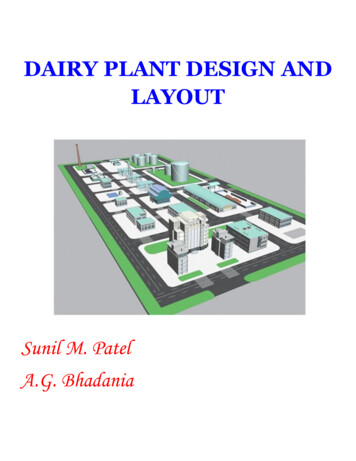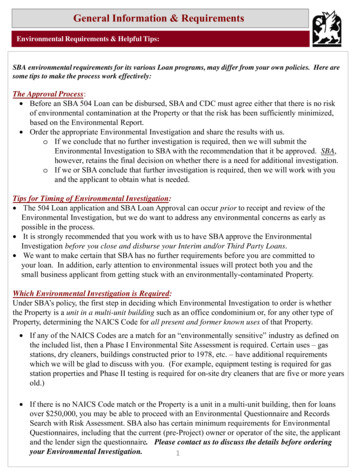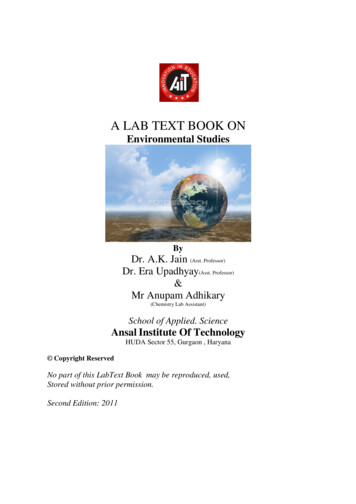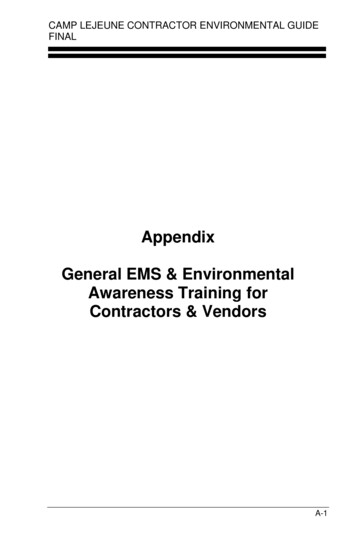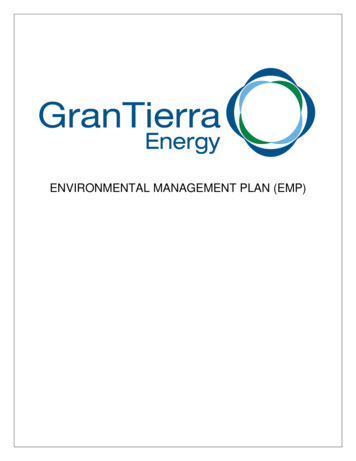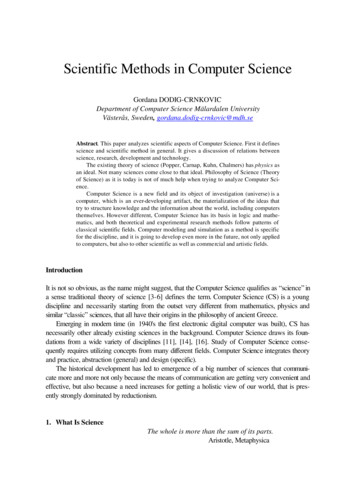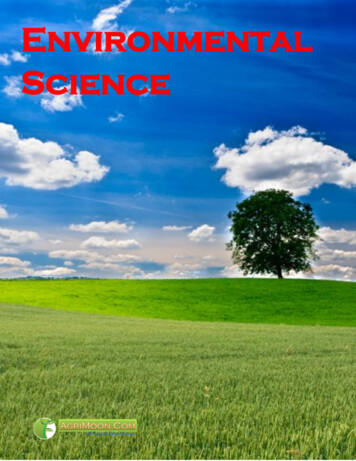
Transcription
EnvironmentalScience
Environmental ScienceAuthorTNAU, Tamil Nadu
IndexLN1234567891011121314151617Lecture NameScope and Importance of Environmental StudiesNatural resources: Renewable and Non renewableresources. Land and WaterNatural resources: forest, wildlife, energy and foodresourcesEcosystems: Definition, concept, structure and functionsProducers, consumers and decomposers of anecosystem. Energy flow in the ecosystem. Types ofecosystemsBio-diversity: Definition, classification, threats tobiodiversity and its conservationEnvironmental pollution: Causes, effects and control of airGlobal warming and climate changeCauses, effects and control of water and marine pollutionCauses, effects and control of soil pollutionCauses, effects and control of noise and thermal pollutionCauses, effects and management of nuclear hazards andindustrial wastesDisaster management, Floods, earthquakes, cyclones andland slidesSocial issues and the environment, unsustainable tosustainable developmentThe Environment Protection Act, the Air Act, the waterAct, the Wildlife Protection Act and Forest ConservationActNational and state level organizations - EnvironmentalLaws and Acts – Environmental Education – CDMWoman and child welfare, HIV/AIDS and Role ofinformation technology on environment and human 91-200201-209
www.AgriMoon.ComLecture 01Scope and Importance of Environmental StudiesEnvironment is derived from the French word Environner, which mean encircle or surrounding.Environment is a complex of many variables, which surrounds man as well as the living organisms.Environmental studies describe the interrelationships among organisms, the environment and all thefactors, which influence life on earth, including atmospheric conditions, food chains, the water cycle,etc. It is a basic science about our earth and its daily activities, and therefore, this science is importantfor one and all.Scope of environmental studiesEnvironmental studies discipline has multiple and multilevel scopes. This study is important andnecessary not only for children but also for everyone. The scopes are summarized as follows: The study creates awareness among the people to know about various renewable andnonrenewable resources of the region. The endowment or potential, patterns of utilization andthe balance of various resources available for future use in the state of a country are analysed inthe study.It provides the knowledge about ecological systems and cause and effect relationships.It provides necessary information about biodiversity richness and the potential dangers to thespecies of plants, animals and microorganisms in the environment.The study enables one to understand the causes and consequences due to natural and maininduced disasters (flood, earthquake, landslide, cyclones etc.,) and pollutions and measures tominimize the effects.It enables one to evaluate alternative responses to environmental issues before deciding analternative course of action.The study enables environmentally literate citizens (by knowing the environmental acts, rights,rules, legislations, etc.) to make appropriate judgments and decisions for the protection andimprovement of the earth.The study exposes the problems of over population, health, hygiene, etc. and the role of arts,science and technology in eliminating/ minimizing the evils from the society.The study tries to identify and develop appropriate and indigenous eco-friendly skills andtechnologies to various environmental issues.It teaches the citizens the need for sustainable utilization of resources as these resources areinherited from our ancestors to the younger generating without deteriorating their quality.The study enables theoretical knowledge into practice and the multiple uses of environment.4
Environmental ScienceImportance of environmental studyEnvironmental study is based upon a comprehensive view of various environmental systems. It aims tomake the citizens competent to do scientific work and to find out practical solutions to currentenvironmental problems. The citizens acquire the ability to analyze the environmental parameters likethe aquatic, terrestrial and atmospheric systems and their interactions with the biosphere andanthrosphere.Importance World population is increasing at an alarming rate especially in developing countries.The natural resources endowment in the earth is limited.The methods and techniques of exploiting natural resources are advanced.The resources are over-exploited and there is no foresight of leaving the resources to the futuregenerations.The unplanned exploitation of natural resources lead to pollution of all types and at all levels.The pollution and degraded environment seriously affect the health of all living things on earth, including man.The people should take a combined responsibility for the deteriorating environment and beginto take appropriate actions to space the earth.Education and training are needed to save the biodiversity and species extinction.The urban area, coupled with industries, is major sources of pollution.The number and area extinct under protected area should be increased so that the wild life isprotected at least in these sites.The study enables the people to understand the complexities of the environment and need forthe people to adapt appropriate activities and pursue sustainable development, which areharmonious with the environment.The study motivates students to get involved in community action, and to participate in variousenvironmental and management projects.It is a high time to reorient educational systems and curricula towards these needs.Environmental studies take a multidisciplinary approach to the study of human interactionswith the natural environment. It integrates different approaches of the humanities , socialsciences, biological sciences and physical sciences and applies these approaches to investigateenvironmental concerns.Environmental study is a key instrument for bringing about the changes in the knowledge,values, behaviors and lifestyles required to achieve sustainability and stability within andamong countries.Environmental studies deals with every issue that affects an organism. It is essentially amultidisciplinary approach that brings about an appreciation of our natural world and human impacts5
www.AgriMoon.Comon its integrity. It is an applied science as it seeks practical answers to making human civilizationsustainable on the earth's finite resources. Its components include or environmental issuesMan and nature have lived together and as long as man‘s wants were in conformity with nature, therewas no problem. But unfortunately, man‘s ambition for limitless enjoyment and comfort has led himtowards the exploitation of nature‘s wealth so indiscriminately as to reduce nature‘s capacity for selfstabilization. The indiscriminate exploitation of nature over centuries has created numerousenvironmental problems. Man‘s voracious appetite for resources and his desire to conquer nature hasput him on collision course with environment. The demands of his explosive technological societyimpose intense stress on the state of equilibrium with the environment. Major environmental issuesthreatening mankind are Global warming, water pollution, pesticide pollution, Hazardous waste,biomedical wastes, e waste, and loss of biodiversityIndia today is one of the first ten industrialized countries of the world. Today we have a goodindustrial infrastructure in core industries like metals, chemicals, fertilizers, petroleum, food etc. Whathas come out of these?, Pesticides, detergents, plastics, solvents, paints, dyes, food additives etc. Due toprogress in atomic energy, there are also been an increase in radioactivity in the biosphere. Besidesthese there are a number of industrial effluent and emissions particularly poisonous gases in theatmosphere. Mining activities also added to this problem particularly as solid waste.Such activities of man had adverse effect on all forms of living organisms in the biosphere. The earthplanet along with the atmosphere (air, land, water) that sustains life is called the Biosphere. Due tolack of development of a culture of pollution control, there has resulted a heavy backlog of gaseous,liquid and solid pollution in our country. The solid wastes which causes pollution are Hazardouswaste, pesticides, medical waste etc. they are become the major environmental issues in addition toautomobile pollution, climate change, water pollution, pesticide pollution and biodiversity loss in ourcountry and worldwide.6
Environmental ScienceIndustrial / Vehicular pollutionThe coolest culprits of environmental degradation in metropolitan cities are vehicular and industrialpollution. Since 1975 the Indian economy has grown 2.5 times, the industrial pollution load has grown3.47 times and the vehicular pollution load 7.5 times, in Delhi, for example 70% of air pollution iscaused by vehicular pollution. Thanks to the 3 million vehicles on its roads-while industries accountfor 17%. The pollutants emitted by the vehicles could produce inflammatory effects on the respiratoryorgans, could be toxic or even carcinogenic depending upon the fuel type, In India, vehicles primarilyrun on diesel or petrol.Air pollutants from automobilesClimate ChangeThe rising concentrations of greenhouse gases (GHGs) of anthropogenic origin in the atmosphere suchas carbon dioxide (CO2), methane (CH4) and nitrous oxide (N2O) have increased, since the late 19thcentury. According to the Third Assessment Report (TAR) of the Intergovernmental Panel on ClimateChange, because of the increase in concentration of greenhouse gases in the atmosphere (for e.g., CO2by 29 per cent, CH4 by 150 per cent and N2O by 15 per cent) in the last 100 years, the mean surfacetemperature has risen by 0.4–0.8 C globally. The precipitation has become spatially variable and theintensity and frequency of extreme events has increased. The sea level also has risen at an averageannual rate of 1–2 mm during this period. The continued increase in concentration of GHG in theatmosphere is likely to lead to climate change resulting in large changes in ecosystems, leading topossible catastrophic disruptions of livelihoods, economic activity, living conditions, and humanhealth. The United Nations Framework Convention on Climate Change requires the parties to protectthe climate system in accordance with their ‗common but differentiated responsibilities‘ and respectivecapabilities. In the year 1990, the developed world (Australia, Canada, USA, Europe, former USSR andJapan) emitted around 66 per cent of the total global GHG emissions, which though has reduced to 54per cent in 2000, mainly offset by the rise in Chinese emissions. The South Asian region, includingthree-fourths emission share of India, contributed only 3 per cent of the total global GHG emissions in1990 and the share of emissions from South Asia has grown merely by 4 per cent in 2000.7
www.AgriMoon.ComWater pollutionIndia has 12 major rivers with a total catchments area of 252.8 million hectare. The Indian homesproduce about 75 % of the wastewater, and sewage treatment facilities are inadequate in most citiesand almost absent in rural India. According to the Central pollution Control Board, of the 8,432 largeand medium industries in the country, only 4,989 had installed appropriate measures to treatwastewater before discharge. Of the over two million small scale industrial units, a number of whichlike tanneries are extremely polluting, very few have any treatment facilities whatsoever and theiruntreated wastes invariably find their way into country‘s water systems.Polluted tankMarine pollutionIndustrial pollutionPoisoned by PesticidesPoisoning from pesticides affects 68,000 farmers and workers every day; annually, an estimated 25million workers suffer from pesticide poisoning throughout the world. Farmers and agriculturalworkers are exposed to pesticides directly when they are mixing and spraying these pesticides,especially so in developing countries such as Asia. Every year, about 3 million people are poisonedaround the world and 200,000 die from pesticide use.8
Environmental ScienceBeyond these reported acute cases of pesticide poisoning, evermore worrying are the chronic long-termeffects such as cancers, adverse effects-not only on specific body organs and systems but also on theendocrine system which include reduction in male sperms count and undecided testes as well asincreasing incidences of breast cancer. Communities and Consumers are insidiously exposed topesticides through contamination of the soil, air and water. The chronic effects of pesticides areparticularly alarming when new studies link certain pesticides to cancer, lowered fertility anddisruption of the endocrine system and to the suppression of immune systems.Important pesticide episodes are The struggles of common plantation workers in Malaysia against the impact of pesticides suchas Parquet as their assertion of their rights as workers.The tale of ex-International Rice Research Institute (IRRI) workers in the Philippines poisonedby pesticides used in the IRRI test fields and unfairly healed by IRRI. There were also detailsabout the fisher flock community in Kamukhaan, Philips, that been poisoned and theirenvironment devastated by Pesticides used in the neighboring banana plantation.The communities living in Kasar code, Kerala who have been poisoned by Endosulfan, whichwas aerially sprayed by the plantation corporation of Kerala, India.Farming and Agricultural Worker communities in Warangal, Andhra Pradesh, who have beenpoisoned by Pesticides during spraying, Warangal is already in famous for the large number ofcotton farmer suicide deaths, one the main reasons during the farmers to suicide in theresistance being developed by pests to pesticides.Pesticides Action Network Asia and the Pacific (PANAD) first launched ‗No Pesticide Use Day‘ in 1998to protest the manufacture and use of pesticides worldwide. The day is held to commemorate thethousand who dies, and the tens of thousand who still suffer and continue to dies, as a result of the1984 Bhopal Disaster. The tragedy of Bhopal is a powerful and poignant example of chemical pesticidecontamination; the victims continue to suffer to this day.9
www.AgriMoon.ComPescticides In Soft DrinksSoft drinks are non-alcoholic water-based flavored drinks that are optionally sweetened, acidulatedand carbonated. Some carbonated soft drinks also contain caffeine; mainly the brown-colored coladrinks. The two global majors PepsiCo and Coca-Cola dominate the soft drink market in India.Coco cola brands -Thumps Up, Limca, sprite, MinuteMaid, and Gold Spot from Parle Beverages and softdrink brands Crush, Canada Dry and Sport Cola fromCadburyPepsico brands - Pepsi-Cola Brands ,FritoLay Brands ,Tropicana Brands ,QuakerBrands ,Gatorade BrandsSample AnalysisA laboratory report prepared by CSE in 2003 detailed some astonishing facts about the extent ofpesticide contamination in soft drinks sold in India. CSE found high levels of toxic pesticides andinsecticides, high enough to cause cancer, damage to the nervous and reproductive systems, birthdefects and severe disruption of the immune system. Market leaders Coca-Cola and Pepsi had almostsimilar concentrations of pesticide residues. At the same time CSE also tested two soft drink brandssold in the US, to see if they contained pesticides. They didn‘t. This only goes to show the companieswere following dual standards.1. Among the total pesticide found in 18 cities inIndia, Kolkata is on the top and Guwahati is in thebottom of that list. Kolkata has pesticide contentin cold drinks of about 51.7 ppb. The pesticidescause irreparable harm to the human body.2. It has been shown time and again that thesepesticides can be used to kill bacteria inbathrooms. The acidic content of these drinks areharmful to the human body.Hazardous waste may be liquid, solid or gas and all have Release of Hazardous waste from industriesone thing in common are dangerous and can pose asubstantial hazard to human health and environmentwhen not managed properly. In India, generation of10
Environmental Sciencehazardous waste to the tune of 6-7 million tonnes peryear and may vary depending on the nature andquantity of hazardous waste generated in India. Themajor hazardous waste in India is petrochemicals,pharmaceuticals, pesticides, paints, dyes, fertilizers,chlor-alkali and other different industriesThe lack of a preventative approach to waste management has led to generation of more and morehazardous wastes and sadly, controlling hazardous waste has become a serious problem in India andno special care is taken in their management. Implementation of the ban on the ground is verynegligent and hazardous waste is coming to our shores in regular phenomenon. Apart-from generatingtheir own hazardous wastes, India invites import to such waste in the name of reuse and recycling,though there is lack of environmental friendly technology to reuse and recycle hazardous waste.Thus indiscriminate generations, improper handling, storage and disposal of hazardous waste are themain factors contributing to the environmental and human health impact. The pressing need is torethink the present approach of pollution control and end-of-the-pipe approaches and focus onpollution prevention, waste minimization, cleaner production and toxics reduction.Dumping of Tannery Sludge:Biomedical Waste11
www.AgriMoon.ComBiomedical waste includes both organic and inorganic wastes generated from hospitals. On an averagea hospital bed generates 1 kg of waste per day, out of which 10-15% is infectious, 5% is hazardous andrest us general waste. Every day, country‘s numerous hospitals and medical facilities churn out tonnesof waste. A WHO report documents that Hepatitis – B Virus can survive in a spring for 8 days.The disposable syringe one uses with asense of security may actually begiving a false sense of security. It mayactually be a used syringe repacked bythe mafia, which is involved in medicalwaste trafficking.Unmediated and unhealed syringe inthe municipal dump may come back inthe hospitals and may then be used ona patient, who may get cross-infected.The problem of Medical waste has acquired gargantuan proportions and complex dimensions. Whilethe health care establishments are trying to provide better medicare facility of the citizens, the hospitalwaste disposal systems are undermining such efforts. The rules for management of this waste exist,what is urgently needed now is training of all the health care staff and setting up waste managementsystem in the hospitals.Plastics constitute a major chunk of medical waste. In fact, in India, the market for medical disposablehas grown from US 2.350 million (1979) to 4,000 million (1986). The use of plastics in medical12
Environmental Scienceequipment is now growing at the rate of 6% per annum. Even though plastics reduce the possibility oftransmission of infection with in the hospital, there are many problems related to its use and disposal.Mercury is more poisonous and Dangerous than Lead and Arsenic.Cracking down on crackersOver the years, Diwali has turned into a festival of pollution by noise, crackers, artificially colouredsweets and serious health hazards. On this day, cities turn into gas chambers increases toxic fumes andgases like CO2, SO2, NO2, as well as suspended particulate matter (SPM), in the air. The worst affectedare children. Pregnant women and those suffering from respiratory problems. In addition, the factoriesmaking crackers float safety norms and exploit child labour. These children work for 16-18 hrs eachday in unhygienic dingy, make-shift and suffocating factories-for only Rs.10-15 per day. They handlechemical that cause deadly diseases of the lungs, kidneys, skin and eyes.E Waste People discard computers every two to four years on average.Cell phones have a life-cycle of less than two years in industrialized countries.Each computer screen contains about 20% lead by weight.A mobile phone, is 19 % copper and 8% iron.Informal name for electronic products nearing end of their ―useful life‖.Large household appliances - Refrigerators Air conditioners, computers & Stereosystems, Mobile phones.Its volume increases by 3-5% per annum.Major pollutants are Heavy metals – Hg, Pb, Cd, Cr (VI) and Flame retardants –Polybrominated biphenyls (PBB) and polybrominated diphenyl ethers (PBDEs).13
www.AgriMoon.ComInternational Scenario 20-50 MT / yr of e waste are generated world-wide.USA accounts 1% to 3% of the total municipal waste generation.EU - 5 to 7 million tonnes per annum or about 14 to 15 kg per capita and is expected to grow at arate of 3% to 5% per year.In developed countries, currently it equals 1% of total solid waste generation and is expected togrow to 2% by 2010.Magnitude of the problem in India India – 1,46,000 tonnes to 4.7 lakh tonnes by 2011.India's e-waste generation is growing at the rate of 15per cent and is expected to cross 800,000tonne by 2012.Sixty-five cities generate more than 60% of the total e-waste in India.Top cities (70%) – Mumbai, Delhi, Bangalore, Chennai, Kolkata, Ahmedabad, Hyderabad,Pune, Surat and Nagpur.50,000 MT / yr illegally imported.Loss of BiodiversityThe continuous loss of biodiversity due to over exploitation, habitat degradation, deforestation andland pollution has posed serious threat to the very existence of the mankind. It has been calculated thatif this trend of biodepletion continues, about 1/4th of the world species may be extinct by the year2050. The rate of destruction which has been of the order of one species per year over the past 600million years is today feared to be dozens of species a day. Hence, the conservation of biodiversity hasbecome one of the most pressing environmental issues. The challenge is for nations, governmentagencies, organizations and individuals to protect and enhance biological diversity, while continuing tomeet people‘s need for natural resources.We are at a major turning point in human history and for the first time, we now have the resources,motivation, and knowledge to protect our environment and to build a sustainable future for ourselvesand our children. Until recently, we didn‘t have these opportunities, or there was not enough clearevidence to inspire people to change their behavior and invest in environmental protection; now theneed is obvious to nearly everyone. Unfortunately, this also may be the last opportunity to act beforeour problems become irreversible.14
Environmental ScienceLecture 02Natural resources: Renewable and Non renewable resources. Land and WaterNatural Resources:A resource is anything needed by an organism or group of organisms. The sum of all physical,chemical, biological and social factors, which compose the surroundings of man, is referred asenvironment and each element of these surroundings constitutes a resource on which man draws inorder to develop a better life. Resources which are not reproducible and are obtained from the fenitenon-living reserves are called non-renewable resources (eg.) Coal and metals.Any material which can be transformed in a way that it becomes more valuable and useful can betermed as a resource. Thus, only part of our natural environment, such as land, water, air, minerals,forest, rangeland, wildlife, fish or even human population that man can utilize to promote his welfaremay be regarded as a natural resource.In the case of humans, a resource is any form of energy ofmatter essential for the fulfillment of physiological, socio-economic and cultural needs, both at theindividual level and that of the community.The five basic ecological variables - energy, matter, space, time and diversity are sometimescombinedly called natural resources.Classification of natural resources:Based on quantity, mutability and reusability schematic representation of classification of naturalresources:15
www.AgriMoon.ComInexhaustibleExhaustible Unlimited or unending Limited. Both qualitative, and quantitativedegradation Quality may be degraded, notquantityRenewableNon-renewable Perpetual harvest No-replacement Ex. Human power, fertility of soil Ex. Species of wild lifeBased on Continual Utility RenewableNon renewableCyclic resourceBased on origin Biotic andAbioticBased on Utility some as raw materialssome as energy resourcesRenewable resources are those which are reproducible and are obtained from the biomass of livingorganisms. (Eg.) Forests. Potentially renewable can become nonrenewable resources, if used for aprolonged time at a faster rate than it is renewed by natural processes.16
Environmental ScienceLandThe land although appears to be available unlimited but, infact, its judicious use would limit theavailability of this indispensable life support system. In rural land use planning, concentration ischiefly devoted to creating and developing more farmland by removing forests and natural grasslands,channeling streams for irrigation and so on. Unfortunately, no effort is made to save existing primefarmland from degradation by ill planned development.A nation‘s well-being is inextricably linked with the fertility and abundance of soil resources.Productive land is since the source of human sustenance and security everywhere at all times, thisresource because of mounting demands of swelling population and long mismanagement would put injeopardy the very survival of man.Deteriorating quality of urban and sub urban environment is to a great extent the result of injudiciousland use and is a threat to the whole socio economic system. Major problems emerging out of abuse ofland in cities include unsafe and unhygienic dwellings and those in rural areas are of erosion of soiland loss of fertility. While urban problems can be prevented and cured by proper town planning andmunicipal facilities, the problem relating to rural areas need long-term soil conservation programme.17
www.AgriMoon.ComSoil consists of mineral and organic matter, air and water. The proportions vary, but the majorcomponents remain the same. Minerals make up 50 per cent of an ideal soil while air and water makeup 25 per cent each. Every soil occupies space. Soil extends down into the planet as well as over itssurface. Soil has length, breadth, and depth. The concept that a soil occupies a segment of the earth iscalled the "soil body". a single soil in a soil body is referred to as a "pedon". The soil body is composedof many pedons and thus called a "polypedon".Every soil has a profile or a succession of layers (horizons) in a vertical section down into the non-soilzone referred to as the parent material. Parent materials can be soft rock, glacial drift, wind blownsediments, or alluvial materials. The nature of the soil profile is important for determining a soil'spotential for root growth, storage of water, and supply of plant nutrients.Soil textureRelative amounts of the different sizes and types of mineral particlesSoil porosityA measure of the volume of pores or spaces per volume of soil and the average distances betweenthese poresSoil permeabilityRate at which water and air move from upper to lower soil layersProcesses of soil formation – 2 stages1) Weathering2) Soil development or pedogenesis Weathering Physical – Wetting- drying, Heating – cooling, Freezing, Glaciations, solution, sand blastChemical - Hydration,Hydrolysis, O/R, Carbonation,Chelation 18
Environmental ScienceSoil development1. Pedogenesis – lichens, bacteria, fungi, algae, microarthropods, mollusc – secretion of Organicacids, enzymes,CO2, addition of Organic Matter – leads to soil formation – soil Profile2. Factors affecting soil formation1. Passive Factors – Parent material, topography, time2. Active Factors – Rainfall, Temp, humidity, Wind,3. Biosphere effect (Phytosphere, Zoosphere, MO)Throughout history, the progress of civilizations has been marked by a trail of wind-blown orwater-washed soils that resulted in barren lands. Continuing to use the soil without appropriate soilconservation management is very destructive to the environment. Protecting the quality of our nation's19
www.AgriMoon.Comtopsoil is largely within human control. To many soil scientists, saving our soil is much more importantthan saving oil, coal, or natural gas resources.Water ResourcesWater is a vitally important substance in all parts of the environment. Water resources occupy a uniqueplace among other natural sources. It is the most abundant and most widely distributed element in theworld. It occupies about three fourths (70%) of the earth‘s surface. It occurs in all spheres of theenvironment – in the oceans as a vast reservoir of saltwater, on land as surface water in lakes andrivers, underground as groundwater in the atmosphere as water vapor, and in the polar icecaps assolid ice. This amounts to a staggering 1400 million cubic kilometer, which is enough to cover the earthwith a layer 3000 meters deep. This apparent abundance is, however, misleading and hides an ironicalfact which is not always fully appreciated, a mammoth 97.5% of the amount, contained in the world‘soceans and seas, being saline, is unfit for human consumption. We, like many creatures, require freshwater to survive, and that constitute a miserly 2.5 % of the total amount. Of this, about 68.9% liesinaccessible in ice fields and glaciers and another 29.9% is present as groundwater. In effect, only one –hundredth of three per cent (0.03%) of the world‘s total supply amounting to some 14 billion cubicmeters is considered easily available for human use on a regular basis. This water is found indecreasing or
science and technology in eliminating/ minimizing the evils from the society. The study tries to identify and develop appropriate and indigenous eco-friendly skills and technologies to various environmental issues. It teaches the citizens the need for su
